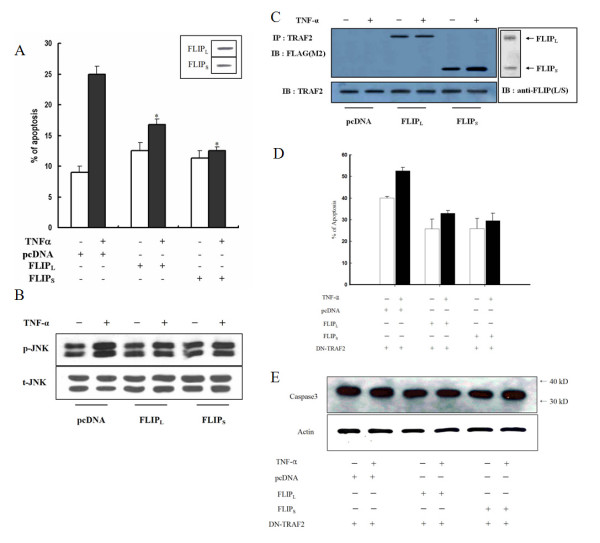Figure 2.
Expression of c-FLIPS confers stronger resistance to TNF-α-induced apoptosis than c-FLIPL, through a TRAF2-dependent mechanism. (A) Analysis of TNF-α-induced apoptosis. SNU-719 cells were transfected with the indicated constructs and treated with 10 ng/ml TNF-α for 24 h. Apoptotic cells were evaluated 48 h after transfection for each construct using the DNA fragmentation assay as described in Materials and methods. After treatment with TNF-α, the percentage of apoptotic cells transfected with pcDNA and c-FLIPL increased, but the percentage of apoptotic cells did not change in cells transfected with c-FLIPS. This experiment was performed three times independently. *P < 0.01 compared with FLIPL and FLIPS. (B) Ectopic expression of c-FLIPL by itself induced the activation of JNK in response to TNF-α, whereas c-FLIPS did not change this effect. P- and t-JNK indicate the phosphorylated JNK and total JNK levels, respectively. (C) SNU-719 cells were transfected with FLAG-tagged c-FLIPL and c-FLIPS expression vectors, incubated with TNF-α (10 ng/ml) for 12 h, and subjected to immunoprecipitation with anti-TRAF2 antibody followed by immunoblotting with anti-FLAG antibody. Immunoblotting of TRAF2 was used as a loading control. (D) To verify the role of TRAF2 in TNF-α-induced apoptosis, SNU-719 cells were cotransfected with the indicated constructs with DN-TRAF2. Apoptotic cells were evaluated 24 h after transfection for each construct using flow cytometric analysis as described in Materials and methods. (E) To confirm the results, we examined caspase 3 activity in the same conditions as described in Fig.2. D. β-Actin was used as a loading control.

